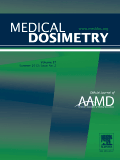
Medical Dosimetry
Scope & Guideline
Exploring the Frontiers of Medical Dosimetry
Introduction
Aims and Scopes
- Radiation Treatment Planning and Optimization:
Research focused on developing and optimizing treatment plans for various cancers, utilizing techniques such as intensity-modulated radiation therapy (IMRT), volumetric-modulated arc therapy (VMAT), and proton therapy. - Dosimetric Evaluation and Quality Assurance:
Studies assessing the dosimetric performance of radiation therapy techniques, including quality assurance methods to ensure accurate dose delivery to patients. - Emerging Technologies in Radiotherapy:
Exploration of novel technologies and methodologies, such as MRI-guided radiotherapy, machine learning applications in treatment planning, and adaptive radiation therapy. - Clinical Applications and Patient Outcomes:
Research emphasizing the clinical implications of dosimetric studies, including treatment outcomes, quality of life assessments, and the management of side effects. - Interdisciplinary Collaboration:
Encouraging collaboration between medical physicists, dosimetrists, oncologists, and other healthcare professionals to improve radiation therapy practices.
Trending and Emerging
- Adaptive Radiation Therapy:
An increasing emphasis on adaptive radiation therapy, which allows for real-time adjustments to treatment plans based on changes in patient anatomy or tumor position. - MRI-Guided Radiotherapy:
A notable trend towards MRI-guided techniques, which enhance treatment precision and enable better visualization of soft tissue targets during radiation delivery. - Artificial Intelligence and Machine Learning Applications:
Growing interest in the application of AI and machine learning for automating treatment planning processes, predicting treatment outcomes, and optimizing dosimetric parameters. - Sparing Organs at Risk (OAR) Strategies:
Heightened focus on methods to minimize radiation exposure to critical structures, particularly in head and neck, breast, and prostate cancers, reflecting a broader commitment to improving patient safety. - Dose Escalation Techniques:
Emerging research on dose escalation strategies, particularly in the context of advanced treatment modalities like SBRT, to enhance tumor control while managing toxicity.
Declining or Waning
- Traditional Brachytherapy Techniques:
Research on conventional brachytherapy methods has decreased as focus shifts towards more advanced radiation delivery techniques, such as stereotactic body radiation therapy (SBRT) and proton therapy. - Standardized Treatment Protocols:
There is a noticeable decline in studies that emphasize the use of standardized protocols across various institutions, as personalized and adaptive treatment approaches gain more attention. - Basic Radiobiology Studies:
The exploration of fundamental radiobiology concepts appears to be waning, with a shift towards studies that integrate clinical outcomes and dosimetric advancements rather than focusing solely on biological effects. - Legacy Treatment Planning Systems:
Research centered on older treatment planning systems is diminishing as newer, more efficient systems with advanced functionalities are being adopted. - Retrospective Studies with Limited Clinical Relevance:
A decline is seen in retrospective studies that do not provide new insights or clinical relevance, as the field increasingly values prospective studies and real-time data analysis.
Similar Journals
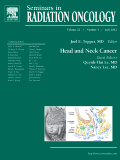
SEMINARS IN RADIATION ONCOLOGY
Transforming Cancer Care through Rigorous ScholarshipSEMINARS IN RADIATION ONCOLOGY is a premier journal published by W B SAUNDERS CO-ELSEVIER INC, dedicated to advancing the field of radiation oncology through high-quality research and comprehensive reviews. With an impressive impact factor and a notable HIndex, this journal holds a prominent place within the academic community, particularly illustrated by its Q2 ranking in both Cancer Research and Oncology, and a Q1 ranking in Radiology, Nuclear Medicine, and Imaging as of 2023. Since its inception in 1991, the journal has served as a vital resource for researchers, clinicians, and healthcare professionals, facilitating the exchange of innovative ideas and practices that shape the future of cancer treatment. While the journal is not open access, it offers essential insights into the latest advancements in the field, catering to a diverse audience eager to expand their knowledge and improve patient outcomes in the realm of radiation therapy.
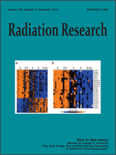
RADIATION RESEARCH
Bridging fundamental insights with applied radiation research.RADIATION RESEARCH is a prestigious journal published by the RADIATION RESEARCH SOC that serves as a vital resource for professionals and researchers in the fields of biophysics, radiation science, and radiology. Established in 1954, this journal has consistently advanced the study of radiation's effects on health and the environment, bridging fundamental and applied research. It boasts an impressive impact factor reflected in its quartile rankings, including Q2 in Biophysics and Q1 in Radiation, making it a highly regarded publication within its discipline. Researchers will find valuable insights through rigorous peer-reviewed articles that explore innovative methodologies and findings related to radiation exposure, imaging technologies, and the biological consequences of radiation. Although the journal does not currently offer open access, it remains a vital reference for academia and industry, fostering a deeper understanding of radiation sciences and their implications for future research and public health.

Radiological Physics and Technology
Advancing knowledge in radiological science.Radiological Physics and Technology, published by SPRINGER JAPAN KK, is a prominent journal that serves as a crucial resource in the multidisciplinary fields of medicine and radiation sciences. With an ISSN of 1865-0333 and an E-ISSN of 1865-0341, the journal has been converging impactful research from 2008 to 2024. It holds a commendable position in academic rankings, currently classified in Q2 in Physical Therapy, Sports Therapy and Rehabilitation and Radiation, along with Q3 for Medicine (miscellaneous) and Radiology, Nuclear Medicine and Imaging. The journal is well-regarded in the academic community, reflected in its Scopus rankings that place it in the upper tiers of its respective categories. Although it currently does not offer Open Access, Radiological Physics and Technology remains a pivotal publication for researchers, academics, and practitioners seeking to advance knowledge and foster innovation in radiological science. Its commitment to disseminating high-quality research ensures its continued relevance and importance within these fields.

Advances in Radiation Oncology
Innovating Radiotherapy for Better Patient OutcomesAdvances in Radiation Oncology, published by Elsevier Inc, is a premier international journal dedicated to the field of oncology and radiology, focusing on the latest groundbreaking research and innovations in radiation therapy. Launched as an Open Access journal in 2016, it has since carved out a significant niche in the academic community, featuring contributions that span a diverse range of topics including clinical practices, technologies, and outcomes in radiation oncology. With an impressive Q2 rankingOncology and Radiology, Nuclear Medicine and Imaging categories for 2023, and positioned within the 65th and 55th percentiles of Scopus ranks, it serves as an essential resource for researchers, medical professionals, and students alike. The journal not only emphasizes the importance of disseminating knowledge widely through its open access model but also aims to foster collaboration and innovation in the evolving landscape of cancer treatment. For those looking to stay at the forefront of radiotherapy research and advancements, Advances in Radiation Oncology is an invaluable platform for scholarly communication.

Translational Oncology
Innovating Tomorrow's Cancer Therapies TodayTranslational Oncology is a premier open access journal published by Elsevier Science Inc, dedicated to the rapidly evolving field of cancer research and oncology. Since its inception in 2008, the journal has been a vital platform for the dissemination of innovative research and findings that bridge the gap between laboratory discoveries and clinical applications. With an impressive impact factor and ranked Q2 in Cancer Research and Q1 in Oncology, it occupies a prominent position in the academic landscape, helping to shape the future of cancer therapeutics and patient care. The journal offers valuable insights across a diverse array of topics, including molecular biology, genetic factors in cancer, and innovative treatment strategies, ensuring relevance and engagement for its readership. As it converges toward 2024, Translational Oncology continues to attract a global audience of researchers, healthcare professionals, and students committed to advancing our understanding of cancer and enhancing clinical outcomes.

PHYSICS IN MEDICINE AND BIOLOGY
Exploring the Intersection of Physics and MedicinePHYSICS IN MEDICINE AND BIOLOGY is a prestigious journal published by IOP Publishing Ltd, with a storied history dating back to 1956 and extending through 2024. This internationally recognized journal caters to the interdisciplinary fields of medical physics and bioengineering, making significant contributions to the research and development of advanced diagnostic and therapeutic technologies. It holds an impressive Q1 ranking in both Radiological and Ultrasound Technology and Radiology, Nuclear Medicine and Imaging categories, reflecting its critical role in disseminating high-quality research. With a significant focus on merging the principles of physics with advancements in medicine, PHYSICS IN MEDICINE AND BIOLOGY serves as an essential resource for researchers, professionals, and students alike, fostering innovation and enhancing collaboration in the healthcare sector. Although the journal is not currently open access, it maintains robust participation in the Scopus database, ranking #62 out of 333 in Radiology, Nuclear Medicine and Imaging and #17 out of 63 in Radiological and Ultrasound Technology, signifying its influence and reach within these disciplines.
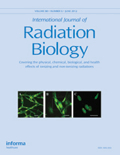
INTERNATIONAL JOURNAL OF RADIATION BIOLOGY
Innovating Insights in Nuclear MedicineINTERNATIONAL JOURNAL OF RADIATION BIOLOGY, published by Taylor & Francis Ltd, has established itself as a premier forum for the dissemination of innovative research related to radiation biology, covering emerging topics that are crucial within the fields of radiology, nuclear medicine, and ultrasound technology. With an ISSN of 0955-3002 and an E-ISSN of 1362-3095, this journal spans over six decades, from its inception in 1959 to 2024, reflecting a rich history of scholarly contribution and a dynamic approach to addressing current challenges in the discipline. Its reputation is highlighted by its Q2 rankings in both Radiology, Nuclear Medicine and Imaging and Radiological and Ultrasound Technology for 2023, underscoring its relevance in a competitive academic landscape, with Scopus rankings placing it in the top tier of its category. While operating under a traditional access model, the journal aims to connect researchers, professionals, and students, facilitating the advancement of knowledge and fostering a deeper understanding of the impact of radiation in various medical applications. The journal plays an essential role in shaping future research directions and enhancing clinical practices globally.
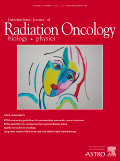
INTERNATIONAL JOURNAL OF RADIATION ONCOLOGY BIOLOGY PHYSICS
Innovating Insights in Radiation Physics and Oncology.International Journal of Radiation Oncology Biology Physics, published by Elsevier Science Inc, is a premier academic journal that has played a critical role in advancing the field of radiation oncology since its inception in 1975. With an impressive impact factor and recognition as a Q1 journal across multiple categories such as Cancer Research, Oncology, and Radiology, this journal serves as a vital resource for researchers, clinicians, and students dedicated to understanding and improving cancer treatment modalities. Its multifaceted scope encompasses original research, reviews, and innovative clinical studies, fostering a deeper understanding of the interplay between radiation, biology, and oncology. With a remarkable ranking in Scopus, including a top position in Radiation Physics and an elite percentile in Oncology, IJROBP remains at the forefront of scientific discovery and innovation in the management of cancer. A traditional subscription model ensures high-quality, peer-reviewed content, providing invaluable insights that continue to advance the standards of care and research in radiation oncology.
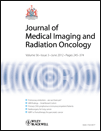
Journal of Medical Imaging and Radiation Oncology
Fostering Innovation in Imaging for Enhanced Cancer CareJournal of Medical Imaging and Radiation Oncology, published by WILEY, is a pivotal resource in the fields of oncology and medical imaging. With an impact factor reflective of its commitment to advancing research, the journal has maintained a robust reputation since its inception in 2008 and continues to thrive through 2024. It is indexed with an insightful ranking, with a Q2 classification in Radiology, Nuclear Medicine and Imaging, affirming its importance in these disciplines. This journal not only serves as an open access platform, allowing extensive reach and accessibility, but also fosters a scholarly community dedicated to the innovation of imaging techniques and radiation oncology practices. As a key player in disseminating crucial findings and advancements, it appeals to researchers, clinicians, and students who aim to contribute to the evolving landscape of medical imaging and cancer treatment methodologies. The journal is based in Australia, at 111 River St, Hoboken, NJ, and invites submissions that push the boundaries of current knowledge in this critical area of healthcare.

Practical Radiation Oncology
Elevating Oncology Through Cutting-Edge ResearchPractical Radiation Oncology is a premier journal published by Elsevier Science Inc., focusing on the critically important fields of Oncology and Radiology, Nuclear Medicine, and Imaging. With an ISSN of 1879-8500, this journal serves as an essential resource for professionals and researchers dedicated to advancing the practice and research of radiation oncology. Established in 2011 and continuing through 2024, it has quickly gained recognition, achieving a prestigious Q2 ranking in Oncology and an exceptional Q1 ranking in Radiology, Nuclear Medicine, and Imaging as of 2023. The journal, housed in New York, USA, provides a platform for innovative research and practical insights, aimed at enhancing therapeutic practices and improving patient outcomes. As part of its commitment to fostering scientific dialogue, it also features a range of articles, reviews, and clinical studies that cater to the diverse interests of its readers. Hard-copy availability combined with digital access ensures a broad reach for the latest advancements in the field.